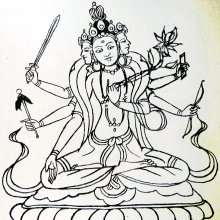Manjukumara, Mañjukumāra, Manju-kumara: 1 definition
Introduction:
Manjukumara means something in Buddhism, Pali. If you want to know the exact meaning, history, etymology or English translation of this term then check out the descriptions on this page. Add your comment or reference to a book if you want to contribute to this summary article.
Images (photo gallery)
In Buddhism
Tibetan Buddhism (Vajrayana or tantric Buddhism)
Source: archive.org: The Indian Buddhist IconographyMañjukumāra (मञ्जुकुमार) refers to one of the various forms of Mañjuśrī having their Sādhana described in the 5th-century Sādhanamālā (a collection of sādhana texts that contain detailed instructions for rituals).—His Colour is red; his Vāhana is the animal; he has three faces and six arms.
The Dhyāna (meditation instructions) of Mañjukumāra is described in the Sādhanamālā as follows:
“The worshipper should think himself as god Mañjukumāra, whois three-faced and six-armed, of red Kuṅkuma, colour. His right and left faces have (respectively) the blue and white colour. He is seated on an animal. His three right hands hold the sword, the arrow and the Varada pose, while the three left carry the Prajñāpāramitā, blue Utpala and the bow. He is decked in princely ornamentsand dress as befitting the Śṛṅgāra (amour) sentiment he displays. He wears the three rags of a mendicant, which are richly decorated with various kinds of flowers. His body is composed of the particles of the Tathāgatas...... Thus meditating...”.

Tibetan Buddhism includes schools such as Nyingma, Kadampa, Kagyu and Gelug. Their primary canon of literature is divided in two broad categories: The Kangyur, which consists of Buddha’s words, and the Tengyur, which includes commentaries from various sources. Esotericism and tantra techniques (vajrayāna) are collected indepently.
See also (Relevant definitions)
Relevant text
Search found 1 books and stories containing Manjukumara, Mañjukumāra, Manju-kumara, Mañju-kumāra; (plurals include: Manjukumaras, Mañjukumāras, kumaras, kumāras). You can also click to the full overview containing English textual excerpts. Below are direct links for the most relevant articles:
The Indian Buddhist Iconography (by Benoytosh Bhattachacharyya)
